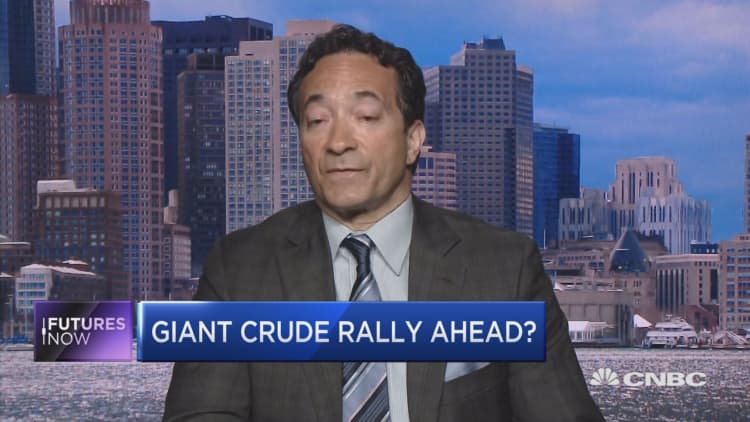
Oil's bearish plunge raises the question of whether OPEC and other producers could make even deeper cuts in production, a double-edged sword that would boost the price, but also encourage more U.S. output.
U.S. oil production has been surging, and that and the recent return of some Libyan oil to the global market has exasperated the still oversupplied market. West Texas Intermediate oil futures for June are down 15 percent since mid-April, losing more than 4 percent Thursday, to $45.77 per barrel. Futures on Brent, the international benchmark fell through the psychological $50 per barrel mark, an important threshold for the global market.
"The bears are in control of this market. My base case is that they extend the cut at current levels, but I think the chances of them doing a deeper cut are higher than a non-extension scenario. No one wins in 30 below conditions," said Helima Croft, global head of commodities strategy at RBC.
At the very least, analysts expect OPEC, led by Saudi Arabia, and other producers to get a deal together to keep the current 1.8 million barrels of production cuts going for several more months. That should help prices recover somewhat, but unclear is whether the market speculation about even bigger production cuts could make it to the bargaining table.
The burden would fall most on Saudi Arabia which has already pared back more than all others. But Saudi Arabia and other Gulf producers are feeling squeezed as prices fall. Just last week, Saudi Arabia returned pay and other benefits that it cut for government workers last year, due to weak prices.
Reuters Thursday quoted an unnamed OPEC delegate saying while there is a strong willingness to extend the deal but, "I have doubts that more cuts will be discussed as the current agreement is yielding a positive outcome."
However, that positive outcome from the cuts is currently difficult to see with shorts swarming the futures market. "I think the market is telling us without a guaranteed extension, we have too much oil around. Once we get the guarantee of six months, we'll see if the market really ignores it," said Gene McGillian, manager market research at Tradition Energy. "If it's not large enough to do it over the six-month or 12-month period, then the price will have a lot of difficulty getting back to levels where we peaked earlier this year." Crude was at its highs of the year in January, but WTI recovered to above $53 in April before beginning to decline again.
Russia's Energy Minister Alexander Novak Thursday was the latest to show support for an extension of the six-month oil production agreement, which expires unless extended at OPEC's May 25 meeting. Novak said in a written statement that Russia is inclined to extend, according to Reuters. But the question is whether the 1.8 million barrels a day OPEC and the other producers have cut would be sufficient to put oil back into the mid $50s., with so much supply on the world market.
"We expected this time of the year to be a weak for demand," said Michael Cohen, head of energy commodities research at Barclays. "We're not into driving season yet so we see this a temporary correction lower but we maintain our bullish stance for Q3, especially if OPEC maintains its cuts. If anything, this type of price environment gets all the deal makers to the table, more so than if it was at $55 or $60."
U.S. oil production has risen to 9.3 million barrels per day, according to the latest U.S. data. "We're 300,000 barrels off the peak output of 2015," Cohen said.
"The drilling activity has been very robust, and a lot of that has come from non-publicly reporting companies and started to see evidence that publicly reporting companies were adding rigs," said Cohen. "We would expect a topping off of the rig count in the next several months." Cohen said a factor potentially impacting shale produers would be rising costs for equipment as demand from drillers increases, a problem particularly if prices are weak.
"Are they putting their foot back in the trap?" said McGillian of the U.S. drillers. "They're getting more aggressive about ramping up their drilling with all that production they're bringing on. If it wasn't for the reduction in supply coming in from the global producers, instead of $50 oil, you could be talking $30."
But some analysts are convinced the market is rebalancing.
"We're going to see if the overhang from the first quarter wears off," said Eric Lee, Citigroup energy analyst. "We think the OPEC cuts are pretty substantial and they help re-balancing the market by drawing down inventories." Lee said he believes the market is at an inflection point where the re-balancing is still not having a visible impact. Part of the problem was that producers increased their output just before the production deal went into effect in January.
"If markets are unconvinced the cuts can meaningfully tighten the market, part of it is because they've been looking at first quarter," said Lee. "We think that we'll see the overhang lifted. We continue to see that's the case despite the sell off today. We're not thinking the market sell off is telling us we should change our view."
He expects Brent to range between $40 and $60 this year.
Watch: Technician sees crude rising 100%



